Interactive Mural
Use your mouse to hover over the dots (or tap them on mobile) to learn more about the depictions in the mural. Best experienced in full screen mode using the button on the bottom right.
Mural Key
Learn more about the depictions in the mural using this non-interactive mural key.
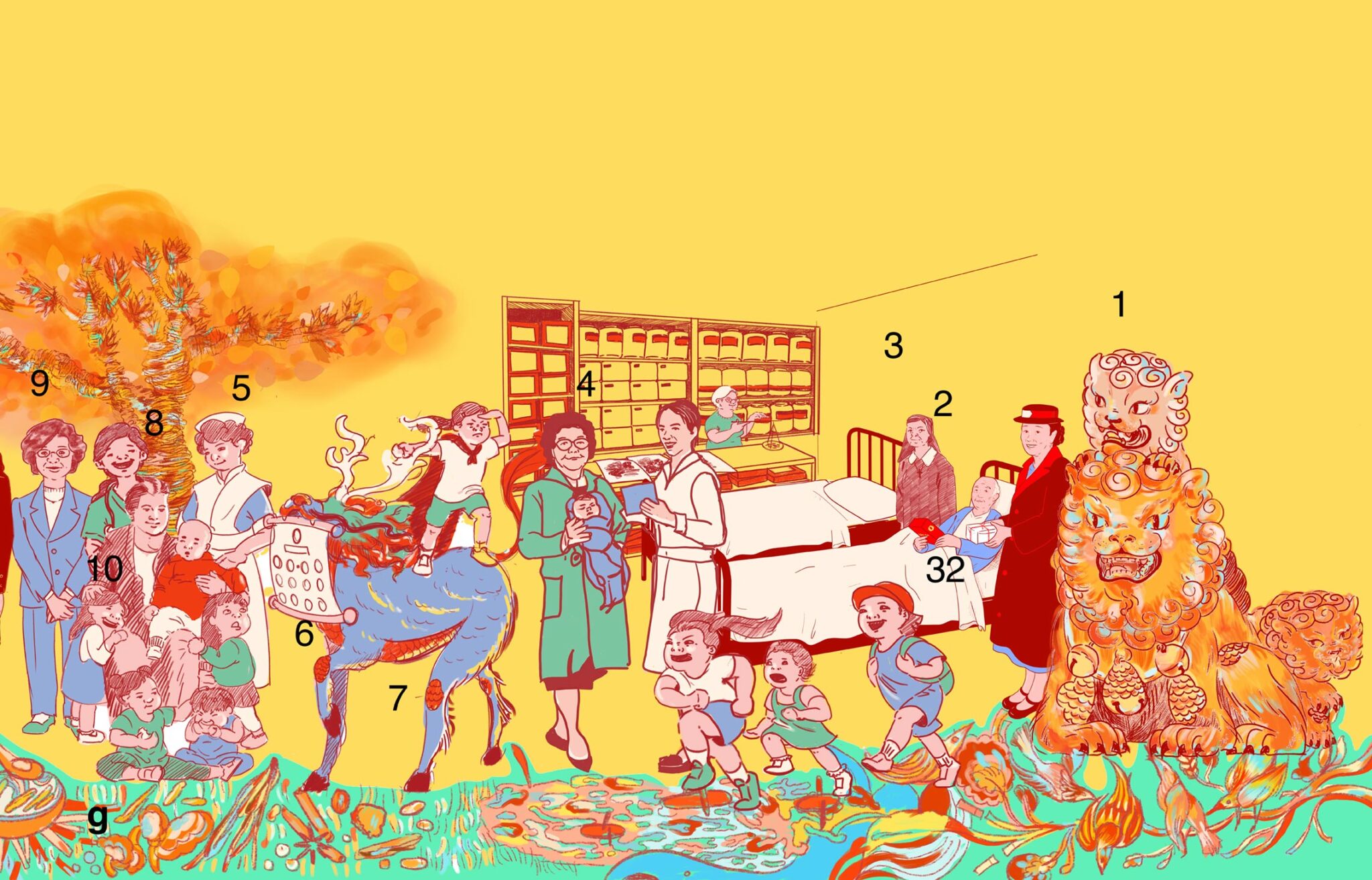
- Guardian Lions: These stone sculptures are commonly presented in pairs, one male and one female, at building entrances as a symbolic gesture to protect the local grounds, buildings, and people. The mural depicts them as maternal lions alongside their cubs, standing at opposite ends to greet visitors.
- Sister Teresa Fung (b. unknown; d. unknown) arrived in Vancouver in 1936 from Canton, China, to assist Quebecois sisters run a mission for Chinese immigrants. She communicated directly with Vancouver’s Chinese community through shared language, working tirelessly to solicit donations and care for the bachelor men.
- Mount Saint Joseph Hospital: The sisters’ mission, or “Chinese Hospital,” began as a small house on Keefer Street (1921) before moving to Campbell Avenue (1924). In 1927, a dedicated three-storey building opened as St. Joseph’s Hospital. In 1946, the current hospital opened at 3080 Prince Edward Street.
- Dr. Madeline Chung (née HUANG 黃文; 1925–2021) was the first Chinese woman obstetrician-gynecologist in BC. Establishing her medical practice in 1953, she helped over 7,200 women deliver their babies. Today, many “Chung babies” are prominent Chinese Canadian lawyers, professors, teachers, artists, community advocates, businesspeople, politicians, and more.
- Women in Medicine and Healthcare: Many pioneering Chinese women in healthcare, including Dr. Victoria Cheung (1897–1966) and nurses Anna Lam Dickman (née Fong; 1906–1996) and Agnes Chan (1904–1962), paved the way for the numerous past and present Chinese Canadian women doctors, nurses, technicians, paramedics, and care workers.
- Chinese Empire Ladies Reform Association (CELRA): Founded in 1903, the Vancouver chapter of CELRA was the first recorded Chinese women’s organization in the region. It built and operated the building currently owned by the Lim Sai Hor Kow Mock Association 林西河總堂九牧公所 at 525 Carrall Street.
- Qilin (Chinese Unicorn): The qilin is a mythical creature symbolizing good luck and prosperity. According to tradition, a qilin will mysteriously arrive to acknowledge the birth or death of a benevolent ruler or sage scholar. This quilin holds a 1903 poster for the CELRA in its mouth.
- Nellie Yip Quong: Nellie Towers (1882–1949) of Saint John, New Brunswick, married Charlie Yip Quong in 1900. A feminist and social activist, “Granny Yip” spoke five Chinese dialects and became an important advocate for her adopted community. She also served as a trusted midwife to some 500 Chinese women.
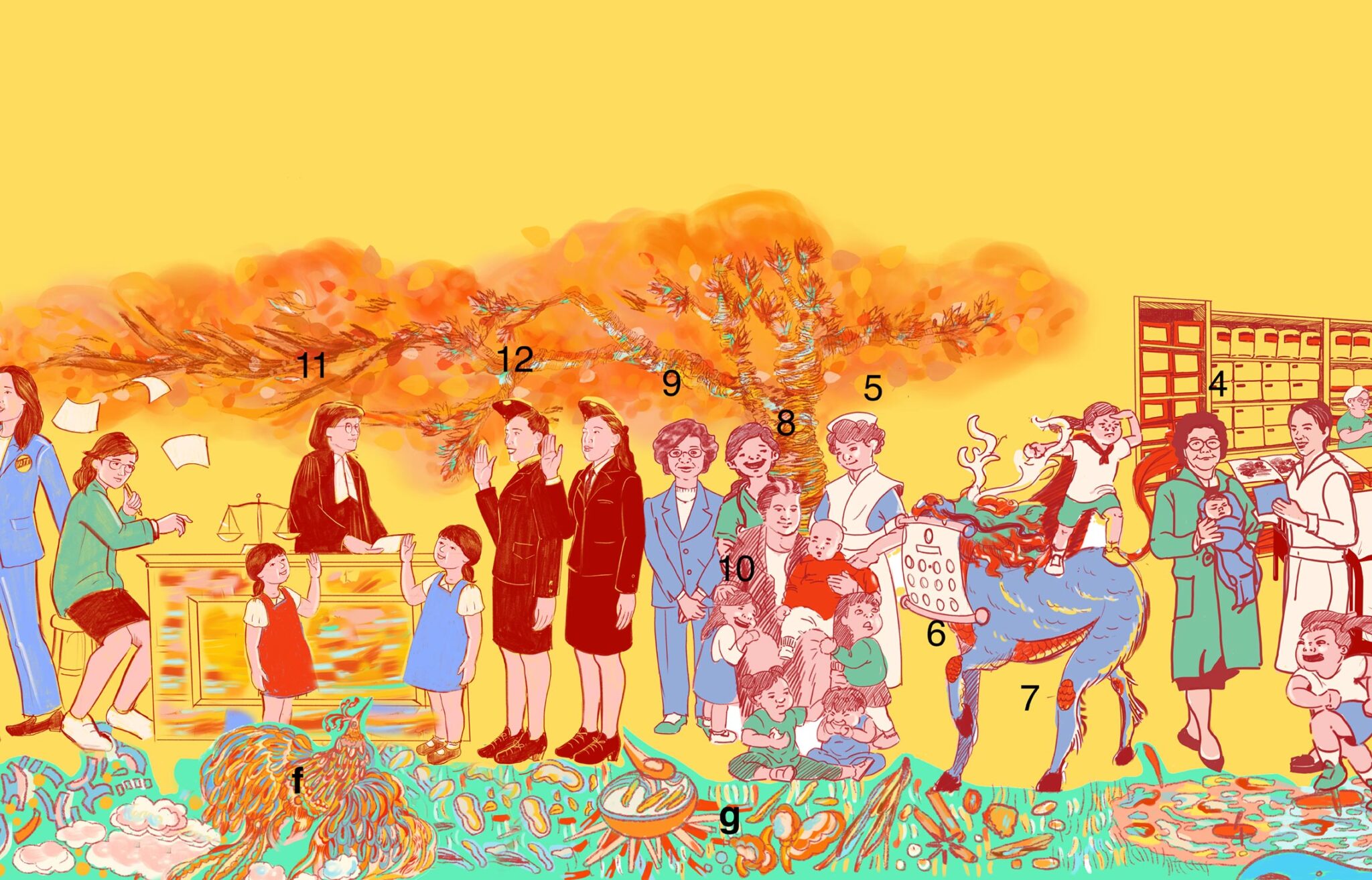
- Lilian To (1945–2005), an advocate of immigrant rights, dedicated her professional life to building a diverse, multicultural society. As CEO of S.U.C.C.E.S.S., she helped the Chinese settlement agency grow into a multiservice and multilingual organization, serving all of Metro Vancouver. In 2016, Shanghai Alley was renamed “Lilian To Way.”
- Women in Social Services: The mural celebrates the many women past and present who have dedicated their professional lives to helping marginalized and underserved populations in the community.
- Women in Law and Government: Among the many pioneering Chinese women in law and government was Margaret Jean Gee (1927–1995). In 1954, at age 26, she became the first woman of Chinese descent called to the bar in Canada. Linda Ann Loo (b. 1947) became the first Chinese woman judge appointed to the BC Supreme Court in 1996.
- Women in the Military: During WWII, Chinese women served in non-combat roles, including with the Women’s Army Corp, such as Private Edna Silaine Lowe, Corporal Lila Wong, Private Marion Laura Mah, Private Mary Ko Bong, and Private Helen Hoe. Jean Suey Zee Lee joined the Royal Canadian Air Force, and dozens of others, such as Peggy Lee, joined the Women’s Ambulance Corps.
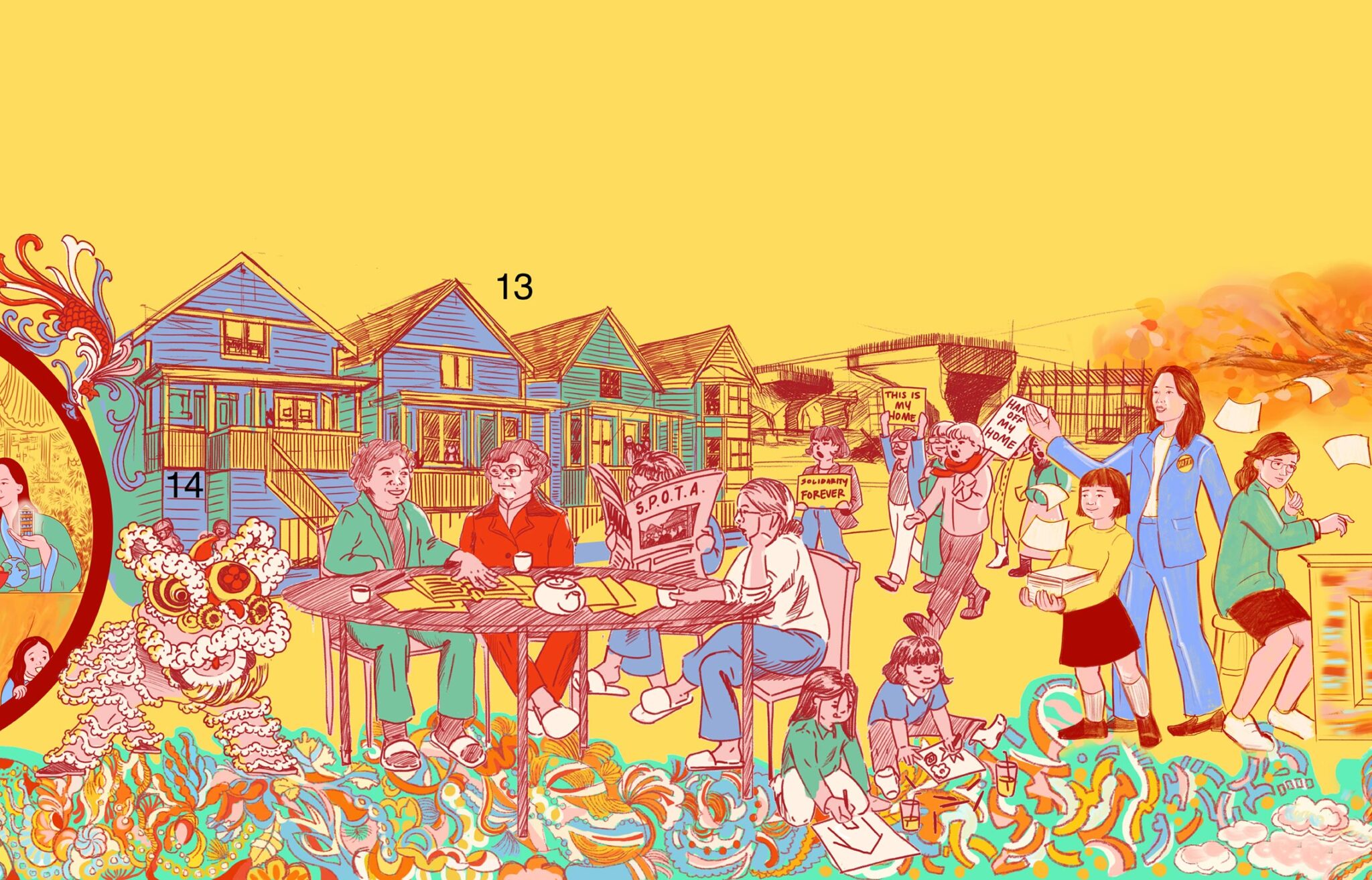
- Strathcona Property Owners and Tenants Association (SPOTA): In the 1960s, many community members—including Mary Chan (1915–2002), Shirley Chan, and Bessie Lee (1924–2016)—established SPOTA to help stop the destruction of older housing stock. They advocated for urban renewal funds to be redirected to repair the neighbourhood’s homes.
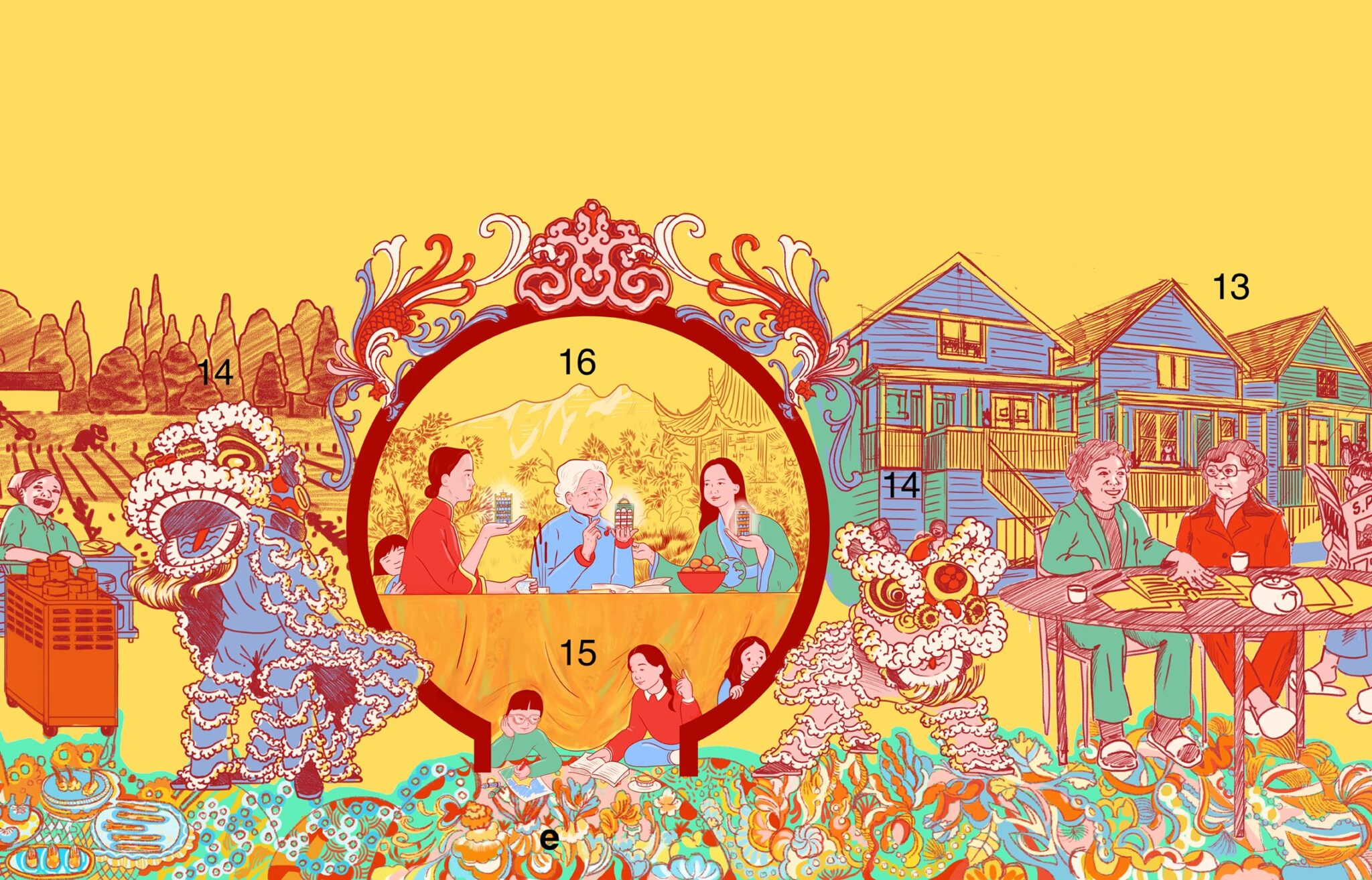
- Lion Dancers: The lion dancers acknowledge the Chinese women who practise an art form traditionally reserved for men. Lion dances are performed to chase away ghosts and evil spirits, accompanied by drums, cymbals, gongs, and firecrackers. This iconic public expression of Chinese culture remains an important part of community celebrations within the diaspora.
- Motherhood, Wisdom, and Independence: The central portal depicts mythical feminine figures of “Motherhood, “Wisdom,” and “Independence” as modern-day women. They hold Chinese Society Buildings in their hands, to acknowledge all the contributions made by women’s groups embedded within Chinatown benevolent societies.
- Gold Mountain: In the distance, we see Vancouver’s twin peaks—known as the Lions or Two Sisters. Their depiction references the notion of Gold Mountain, or Gum San, a name Chinese immigrants gave to Californian, British Columbian, and Australian colonies as places where immigrants sought wealth and prosperity.
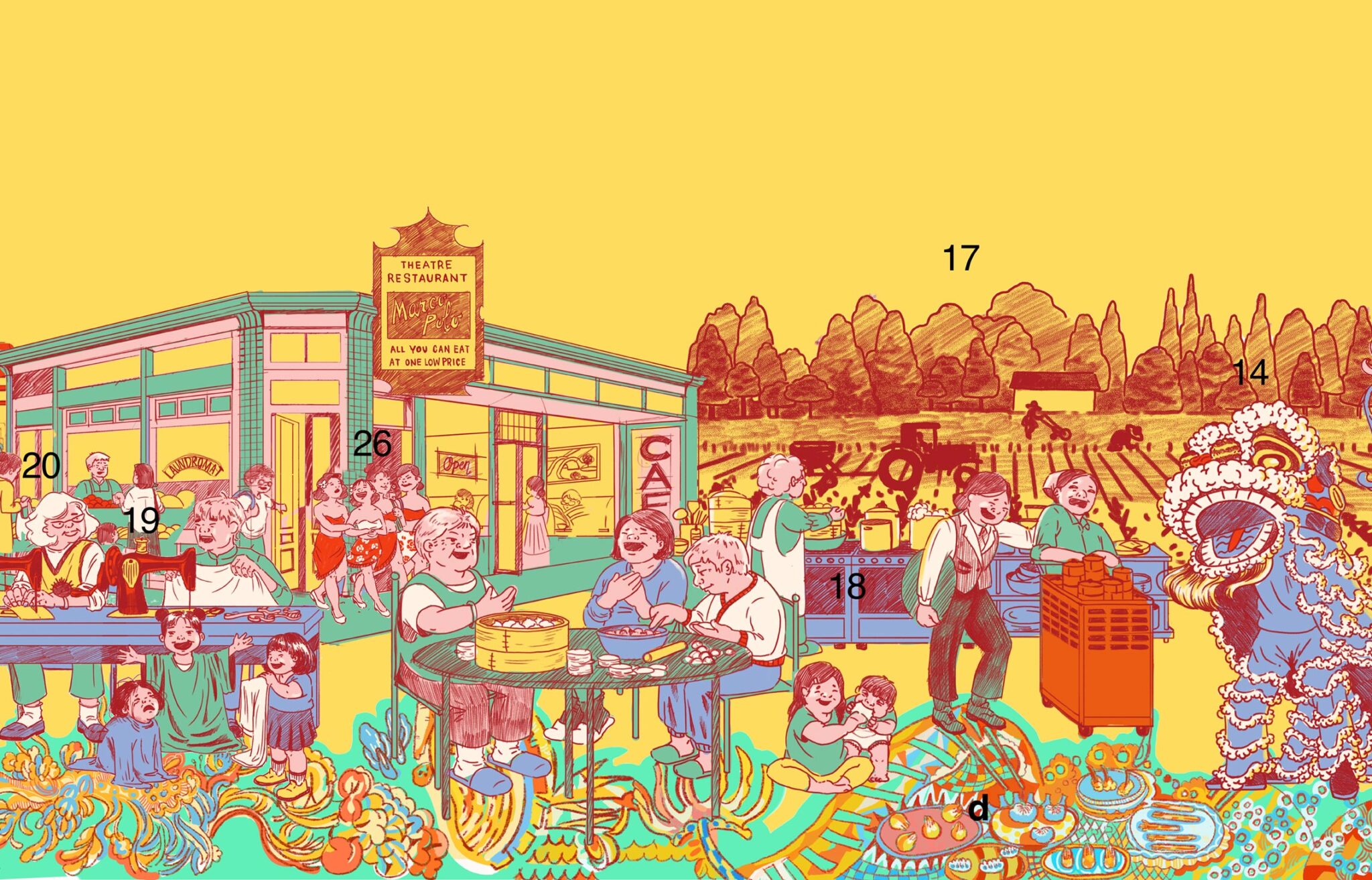
- Women in Agriculture: Many past and present-day Chinese women have worked tirelessly to raise families and work the land on farms in the Lower Mainland. They supplied produce to grocers both in and outside Chinatown. It is estimated that, by 1921, Chinese immigrant farmers produced 90 percent of BC’s vegetables.
- Women in Food and Service Industries: These figures celebrate the many historical and present-day women who worked in food and service to support themselves and their families. Discriminatory labour laws forced people of Chinese descent to work in restaurants and laundries. After 1947, many women found their way by working long hours for low pay in these sectors.
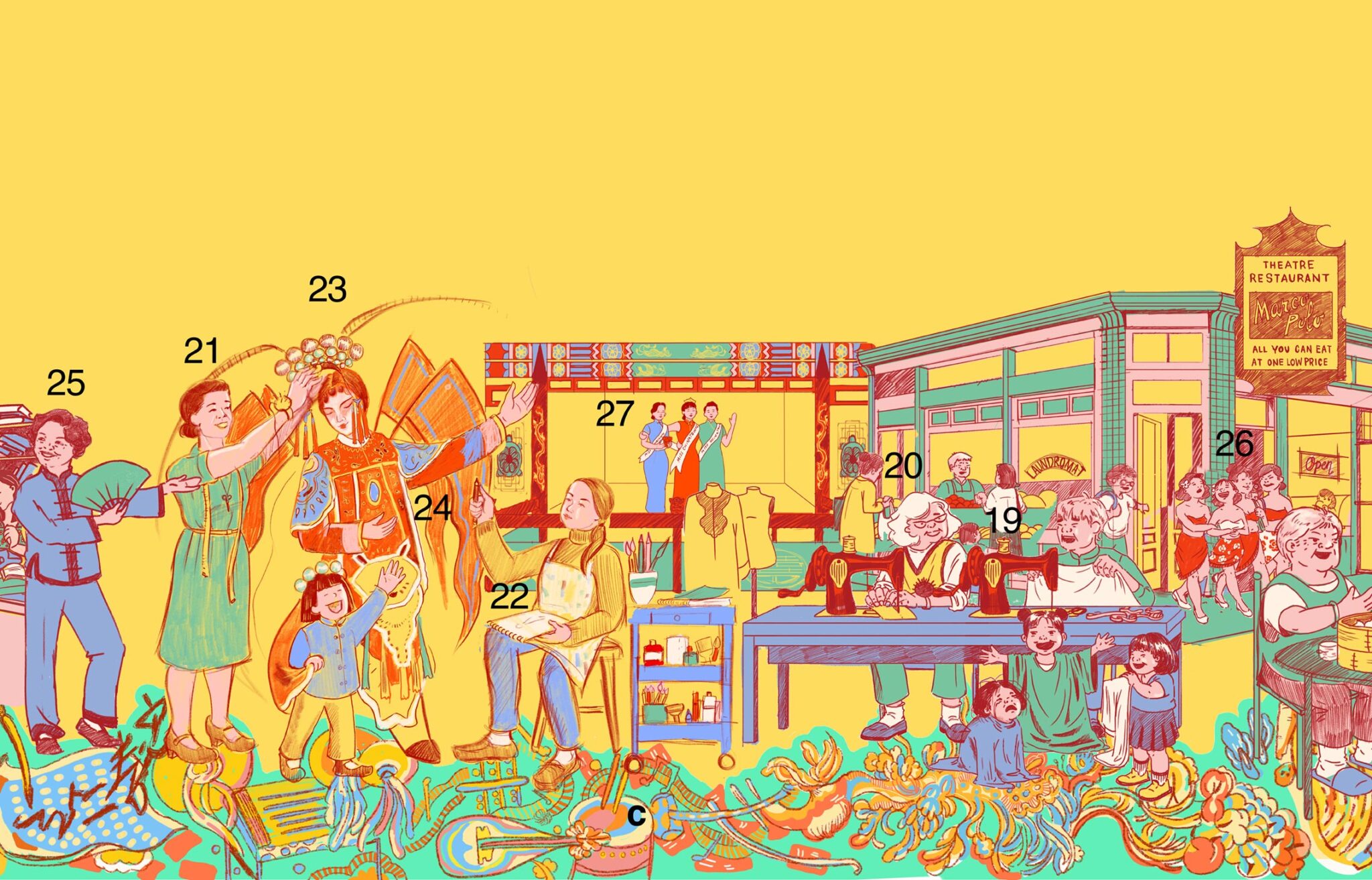
- Women in Textiles: Many Chinese women worked in Vancouver’s textile and garment industry over the last century. During the mural’s community engagement phase, women shared stories about female family members who worked as seamstresses for long hours with minimal pay and benefits to support their families, especially in the 1970s and ’80s.
- These seamstress figures pay tribute to women such as Sue Gee Jackman (1909–2008), Lillian Yet Moi Chang (1926–2021), and Mia Wu (unknown)—past and present business owners who carried on the traditions of Chinese textiles and fashion heritage in Chinatown.
- Women Entrepreneurs: Many trailblazing women defied gender roles and pursued independent careers as business leaders and owners in Chinatown. Many present-day women continue family and traditional heritage businesses in the neighbourhood, including Olivia Chan, Susanna Ng, Mia Wu, Tannis Ling, and Carol Lee, to name just a few.
- Anna Wong (1930–2013) was born and raised in Chinatown and worked in her family’s business, Modernize Tailors. She graduated from Vancouver School of Art and then taught printmaking at Pratt Graphics Center in New York. During her career, she represented Canada in a number of international print biennials.
- Women in the Arts—Chinese Opera, Literature, Visual Arts: The mural acknowledges Chinese women working in arts and culture, past and present. During the research phase, community members shared stories about the old Sing Kew Theatre in Shanghai Alley, a gathering place and venue to enjoy traditional Cantonese opera.
- The mural features Muk Kwai-ying, a.k.a. Mu Guiying (穆桂英), the famous woman warrior character with bound feet who appears in Cantonese opera.
- Maria Mimie Ho (1942–2010) founded the Strathcona Chinese Dance Company in 1973. For 37 years, Ho directed the company and spread her love of Chinese culture. She also taught Mandarin and math at Templeton Secondary School in Vancouver and was a significant community leader, receiving the city’s Civic Merit Award.
- “China Doll” dancers: The women who entertained patrons at Marco Polo, a legendary nightspot in Chinatown, were known as the “China Doll” dancers. The club was one of the city’s most significant live entertainment venues in the 1960s and ’70s.
- Miss Vancouver Chinatown: In 1960, the Miss Vancouver Chinatown pageant was launched by Chinatown businesses, including H. Y. Louie, Ming’s Restaurant, and Modernize Tailors. Donna (Yee) Chan won the first year. The pageant ran only one year, but was revived by the Vancouver Chinatown Lions Club in 1977. In 1995, Fairchild TV became the main sponsor and renamed the pageant Miss Chinese Vancouver.
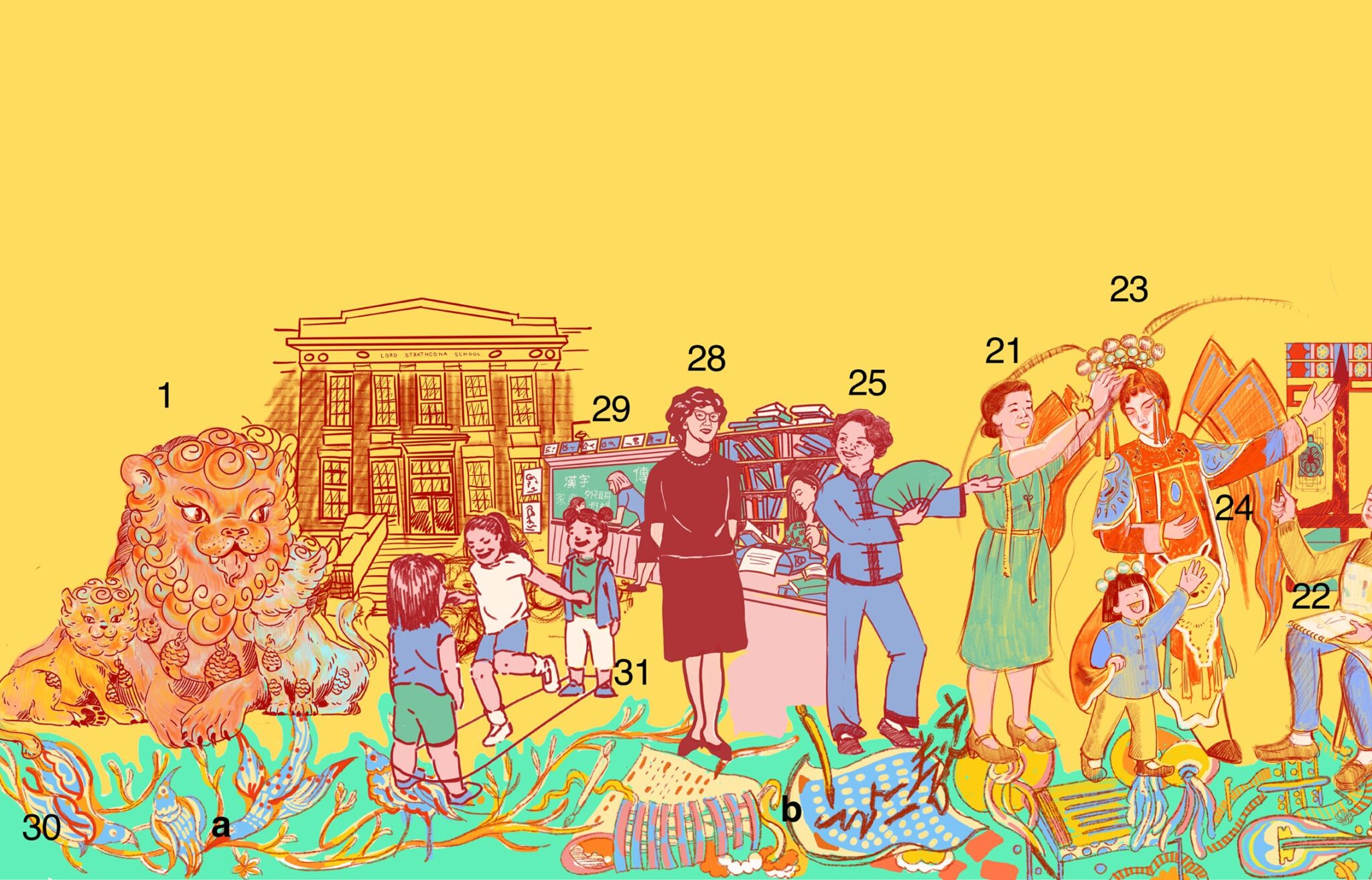
- Vivian Mabel Jung (1924–2014), the first woman of Chinese descent hired by the Vancouver School Board, taught at Tecumseh School for 35 years. Many women who grew up in Chinatown remember their experiences attending Strathcona Elementary School (English school) and Chinese school.
- Women in Education and Chinese School: Chinese school programs provided culture and language education for children of Chinese heritage. The importance of this type of intergenerational learning cannot be overstated. This mural project would not have been possible without women sharing their personal histories and lived experiences.
- Flora, Fauna, Mythical Creatures, Traditional Chinese Medicinal Herbs, Cultural Foods, and Symbolic Chinese Flowers run along the bottom of the mural. The floral depictions were inspired by contributions from seniors residing at the S.U.C.C.E.S.S. Simon K.Y. Lee Seniors Care Home.
A. Oriental magpies are an omen of good fortune and joy.
B. The “Four Treasures of the Study” in calligraphy are the brush, ink, paper, and ink stone. The calligraphy here reads: 忠孝仁义 (loyalty, filial piety, benevolence and righteousness), which are the four virtues in Confucianism. This interpretation symbolizes the importance of intergenerational learning and education for women.
C. Chinese traditional instruments, commonly used in Chinese operas, include the pipa, Chinese drum, dizi, and erhu. They complement the figures of women in the arts above.
D. Dim sum is an important cultural cuisine originating in Guangdong province and Hong Kong, and spread throughout diasporic communities around the world.
E. These symbolic flowers incorporate still life drawings by local Chinese seniors, highlighting Moutan peony and Chinese peony to symbolize prosperity and happiness.
F. Phoenixes in Chinese mythology are immortal birds that harmoniously bring together male and female traits. Their rare appearance signifies harmony and benevolence.
G. Traditional Chinese medicine is thousands of years old and uses many herbs to treat human diseases and as supplements for health and wellness. The imagined natural herbs illustrated here symbolize the Chinese philosophy 天人合一 (“harmony between man and nature”). - Children appear at the feet of adults throughout the mural. They are shown learning, playing, helping, listening, observing, and generally causing mischief. They represent motherhood and sisterhood, as well as the importance of intergenerational learning and the passing on of cultural traditions and language.
- Due to the 1923 Chinese Exclusion Act, the growth of the Chinese Canadian community was stunted. Many Chinese “bachelors” became stranded without their families. Showing children in the mural is especially important for a community that was forced into gender imbalance for decades, before the Act was repealed in 1947.
